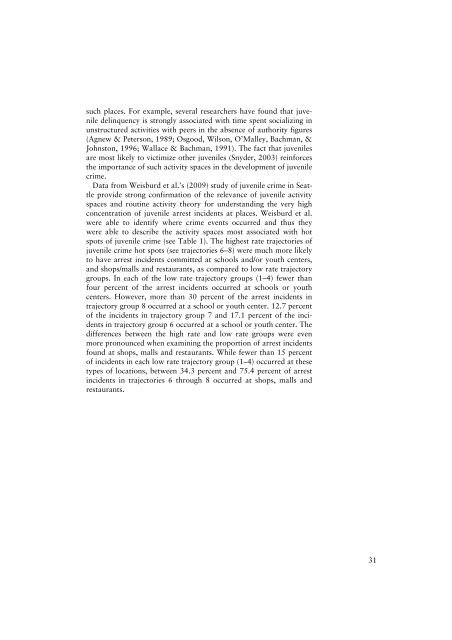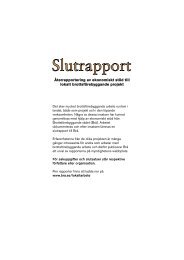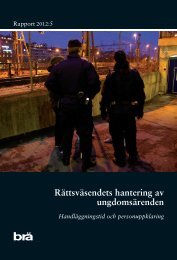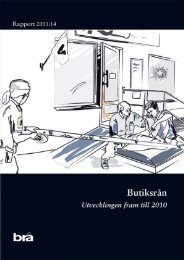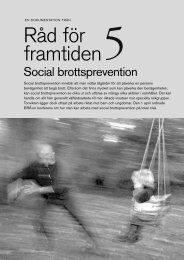such places. For example, several researchers have found that juveniledel<strong>in</strong>quency is strongly associated with time spent socializ<strong>in</strong>g <strong>in</strong>unstructured activities with peers <strong>in</strong> the absence <strong>of</strong> authority figures(Agnew & Peterson, 1989; Osgood, Wilson, O’Malley, Bachman, &Johnston, 1996; Wallace & Bachman, 1991). <strong>The</strong> fact that juvenilesare most likely to victimize other juveniles (Snyder, 2003) re<strong>in</strong>forcesthe importance <strong>of</strong> such activity spaces <strong>in</strong> the development <strong>of</strong> juvenilecrime.Data from Weisburd et al.’s (2009) study <strong>of</strong> juvenile crime <strong>in</strong> Seattleprovide strong confirmation <strong>of</strong> the relevance <strong>of</strong> juvenile activityspaces <strong>and</strong> rout<strong>in</strong>e activity theory for underst<strong>and</strong><strong>in</strong>g the very highconcentration <strong>of</strong> juvenile arrest <strong>in</strong>cidents at places. Weisburd et al.were able to identify where crime events occurred <strong>and</strong> thus theywere able to describe the activity spaces most associated with hotspots <strong>of</strong> juvenile crime (see Table 1). <strong>The</strong> highest rate trajectories <strong>of</strong>juvenile crime hot spots (see trajectories 6–8) were much more likelyto have arrest <strong>in</strong>cidents committed at schools <strong>and</strong>/or youth centers,<strong>and</strong> shops/malls <strong>and</strong> restaurants, as compared to low rate trajectorygroups. In each <strong>of</strong> the low rate trajectory groups (1–4) fewer thanfour percent <strong>of</strong> the arrest <strong>in</strong>cidents occurred at schools or youthcenters. However, more than 30 percent <strong>of</strong> the arrest <strong>in</strong>cidents <strong>in</strong>trajectory group 8 occurred at a school or youth center. 12.7 percent<strong>of</strong> the <strong>in</strong>cidents <strong>in</strong> trajectory group 7 <strong>and</strong> 17.1 percent <strong>of</strong> the <strong>in</strong>cidents<strong>in</strong> trajectory group 6 occurred at a school or youth center. <strong>The</strong>differences between the high rate <strong>and</strong> low rate groups were evenmore pronounced when exam<strong>in</strong><strong>in</strong>g the proportion <strong>of</strong> arrest <strong>in</strong>cidentsfound at shops, malls <strong>and</strong> restaurants. While fewer than 15 percent<strong>of</strong> <strong>in</strong>cidents <strong>in</strong> each low rate trajectory group (1–4) occurred at thesetypes <strong>of</strong> locations, between 34.3 percent <strong>and</strong> 75.4 percent <strong>of</strong> arrest<strong>in</strong>cidents <strong>in</strong> trajectories 6 through 8 occurred at shops, malls <strong>and</strong>restaurants.31
Table 1: Juvenile Trajectory Group Membership by Location <strong>of</strong> Incident(N = 30,004).School,YouthCenterShops,Malls,RestaurantsStreet,Alley,PublicSpacesLocation <strong>of</strong> IncidentPrivateDwell<strong>in</strong>gBars,Clubs,TavernsOtherTotalGroup1 1.9% 10.2% 32.1% 47.3% .2% 8.3% 100.0%2 1.8% 2.1% 53.7% 34.3% .1% 8.0% 100.0%3 2.9% 4.8% 43.3% 40.1% .3% 8.6% 100.0%4 3.9% 14.3% 42.5% 29.8% .2% 9.3% 100.0%5 6.5% 26.0% 40.7% 14.3% .4% 12.2% 100.0%6 17.1% 34.3% 32.5% 5.2% 2.5% 8.4% 100.0%7 12.7% 75.4% 8.8% .2% .1% 2.9% 100.0%8 30.7% 38.9% 21.5% .7% .0% 8.0% 100.0%Source: Weisburd, Morris, <strong>and</strong> Gr<strong>of</strong>f (2009).<strong>The</strong>se data provide important support for the assumption that juvenilecrime is concentrated because <strong>of</strong> the concentration <strong>of</strong> juveniles<strong>in</strong> juvenile activity spaces. Incidents <strong>in</strong> the highest rate trajectorieswere most likely to be found at <strong>and</strong> around schools <strong>and</strong> youth centers,or shops, malls <strong>and</strong> restaurants. This means that hot spots <strong>of</strong>juvenile crime, as evidenced by arrest <strong>in</strong>cidents, are likely to be located<strong>in</strong> places where juvenile congregate. Not surpris<strong>in</strong>gly, givenWeisburd et al.’s (2009) focus on juvenile crime, very few arrest<strong>in</strong>cidents are found at bars, clubs <strong>and</strong> taverns. While prom<strong>in</strong>entactivity places for adults, <strong>and</strong> <strong>of</strong>ten crime hot spots (Roncek & Bell,1981; Roncek & Maier, 1991), they are not part <strong>of</strong> the activityspaces <strong>of</strong> juveniles.While rout<strong>in</strong>e activities theory has been a central feature <strong>of</strong> recent<strong>in</strong>terest <strong>in</strong> crime hot spots, it is important to note that other theoreticalapproaches might also be important <strong>in</strong> underst<strong>and</strong><strong>in</strong>g crimeat place <strong>and</strong> develop<strong>in</strong>g effective crime prevention approaches. Ecologicaltheories <strong>of</strong> social disorganization used to expla<strong>in</strong> crime patterns<strong>in</strong> communities (see Schmid, 1960a, 1960b; Shaw & McKay,1942 [1969]), for example, might also be applied to crime hot spots(see Smith et al., 2000). Recent research by Weisburd, Gr<strong>of</strong>f <strong>and</strong>Yang (In progress) suggests that social disorganization theories mayhave strong relevance for crime prevention at place.For example, scholars have recently emphasized the importance <strong>of</strong>“collective efficacy” <strong>in</strong> communities as an <strong>in</strong>dicator <strong>of</strong> a community’sability to realize common values <strong>and</strong> regulate behavior (see32
- Page 2 and 3: The Importance of Place inPolicingE
- Page 4: ContentsForeword ..................
- Page 7 and 8: eport note for example that this ne
- Page 9 and 10: 8licing. By place, we do not mean l
- Page 12 and 13: II. The Emergence of CrimePlaces in
- Page 14 and 15: For many scholars and policymakers,
- Page 16 and 17: III. The Concentration ofCrime at P
- Page 18 and 19: viduals. Using his Minneapolis data
- Page 20 and 21: more, Maryland using a panel design
- Page 22 and 23: Figure 3: Trajectories of Individua
- Page 24 and 25: V. The Importance of Place-Based Ra
- Page 26 and 27: Figure 5: Kernel Density Estimation
- Page 28 and 29: Perhaps the most comprehensive geog
- Page 30 and 31: masked if we focused our interest o
- Page 34 and 35: Sampson et al., 1997; Sampson, 2004
- Page 36 and 37: Table 3: Relationship Between Numbe
- Page 38 and 39: sas City Crack House Raids Experime
- Page 40 and 41: The Campbell review reported notewo
- Page 42 and 43: VIII. Does Crime Just MoveAround th
- Page 44 and 45: prevention effect. The Campbell sys
- Page 46 and 47: know. This way, if I need help, I k
- Page 48 and 49: IX. Reducing LegalConstraints while
- Page 50 and 51: X. Recognizing theImportance of Pol
- Page 52 and 53: esidents and business owners in hig
- Page 54 and 55: demands a fundamental change in the
- Page 56 and 57: concern of police to improving plac
- Page 58 and 59: ReferencesAgnew R., & Peterson D. M
- Page 60 and 61: Bushway, S. D., Thornberry, T. P.,
- Page 62 and 63: Estricht, S., Moore, M. H., McGilli
- Page 64 and 65: Mastrofski, S. M., Weisburd, D., &
- Page 66 and 67: Sherman, L. W. (1990). Police crack
- Page 68 and 69: Evaluating public policy initiative


